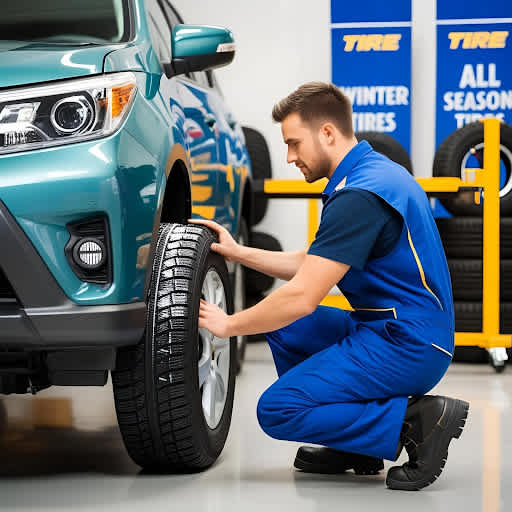Tire Maintenance & Safety
Best price guarantee
Tire replacement coverage
24/7 roadside assistance
Easy returns
When to Switch from Winter to All-Season Tires

As the winter season draws to a close, it's essential for vehicle owners to consider swapping their winter tires with all-season ones. This switch is crucial for maintaining optimal safety and performance during the warmer months.
Changing tires seasonally may seem like an extra hassle, but it's a valuable investment in your vehicle's longevity and your own peace of mind. By understanding the benefits of switching to all-season tires and knowing when to make the change, you can ensure that your vehicle is well-equipped to handle different road conditions.
In this article, we'll explore the reasons behind switching from winter to all-season tires and provide expert guidance on determining the right time to make the switch. We'll also walk you through the steps involved in the tire changeover process, ensuring that you're prepared for the upcoming season beforehand.
Why is Winter to All-Season Tire Swap A Must?
Winter tires are specifically designed to provide superior traction, handling, and braking performance in cold weather conditions, including snow, ice, and slush. However, as temperatures rise and road conditions improve, winter tires become less effective and can even lead to reduced performance and faster wear on warm and dry surfaces.
Going for all-season tires is essential for ensuring optimal safety and performance during the warmer months. All-season tires are engineered to provide a balance of performance characteristics, including good traction in wet and dry conditions, comfortable ride quality, and longer tread life.
By switching to all-season tires at the right time, you can:
- Improve fuel efficiency: All-season tires typically have low rolling resistance compared to winter tires, which can lead to better fuel economy.
- Enhance handling and stability: The tread compound and pattern of all-season tires are optimized for warmer temperatures, providing better handling and stability on dry and wet roads.
- Extend tire life: Using winter tires in warm weather can cause them to wear out more quickly due to the softer tread compound. Switching to all-season tires helps preserve the life of your winter tires, saving you money in the long run.
- Reduce road noise: All-season tires generally produce less road noise than winter tires, providing a quieter and more comfortable ride.
Switching from winter to all-season tires at the appropriate time is a simple yet effective way to ensure that your vehicle is well-equipped to handle the changing weather conditions. By investing in a set of high-quality all-season tires, like those offered at SimpleTire, you can enjoy peace of mind knowing that your vehicle is ready for the road ahead.
How to Determine the Right Time to Switch Tires
Choosing the right time to move from winter to all-season tires involves careful consideration of temperature trends and weather forecasts. As a rule of thumb, when daily temperatures consistently climb above 45 degrees Fahrenheit, it's advisable to start thinking about the switch. This temperature benchmark ensures that tires optimized for warmer conditions can deliver their best performance without sacrificing safety or durability.
The more familiar you are with your region's climate patterns, the more timely you can perform the tire change. Pay attention to seasonal shifts and check for any late-season cold spells. Experts recommend planning your tire change during a stretch of steady, warm weather to guard against unexpected winter-like conditions. By aligning your tire change with these considerations, you ensure that your vehicle operates safely and efficiently throughout the year.
Step 1: Monitor Temperature Changes
Temperature serves as a vital indicator for knowing when to go from winter to all-season tires. When the mercury consistently registers above 45 degrees Fahrenheit, it's advised to initiate the tire change. This temperature-bound change allows your tires to adapt effectively to the milder, often wetter conditions of spring and summer.
Check early morning temperatures, as they tend to be cooler than midday peaks. This fluctuation can influence tire performance, especially if winter tires linger on the vehicle too long. During such cooler temperatures, you should ensure that the tires aren't too soft, which could lead to rapid wear, nor too stiff, which might compromise grip.
By diligently monitoring temperature trends, drivers can adopt a proactive approach to tire maintenance. Keeping an eye on both daytime highs and nighttime lows makes things clear as to when conditions favor all-season tires to ensure peak performance and increased safety.
Step 2: Evaluate Your Driving Conditions

Assessing your local driving conditions is key when determining the right time to switch from winter to all-season tires. Regions vary widely in weather patterns, which can range from frequent rain to predominantly dry, warm roads as seasons shift. Carefully consider these factors, as they directly impact how your tires perform. In areas where dry conditions prevail, all-season tires offer improved traction and control, making them an ideal choice.
While winter tires excel in icy and snowy conditions, they can wear out more quickly on dry, warm roads due to their softer rubber compounds. This can lead to diminished performance and longevity. All-season tires, on the other hand, are designed to handle a variety of conditions effectively. They provide reliable traction and durability, adapting to changing temperatures and ensuring a smoother, more secure driving experience in regions with variable weather.
Step 3: Check Tire Tread and Wear
Before you go swapping winter tires with all-season tires, you should evaluate the current state of your winter tires. This inspection is essential for maintaining safety and ensuring tires are ready for future use. Focus on identifying any signs of excessive tread wear, which might suggest issues like misalignment or improper inflation. If tread depth is nearing its limit, replacing those tires becomes necessary.
Examining tire conditions now helps prevent future problems and extends their lifespan. Early detection of wear allows for timely corrections, preserving the tire's overall health. Addressing potential issues promptly ensures your winter tires will be in top shape for the next cold season, saving you both time and money in the long run.
Additionally, inspect the sidewalls for any visible damage, such as cuts or cracks, which could impact performance. Identifying and resolving these concerns early contributes to safer driving and maximizes the value and longevity of your tire investment.
Step 4: Understand the Benefits of All-Season Tires
All-season tires excel in providing consistent performance across diverse driving conditions. Unlike winter tires, which are designed for extreme cold and snow, or summer tires, which handle heat and dry roads, all-season tires blend features suitable for year-round use. This makes them a practical choice for drivers in regions with mild seasonal changes.
A key advantage of all-season tires is their groove and siping design, crafted to offer dependable traction in both wet and dry environments. This design ensures stability and control during unexpected rain showers or on dry asphalt, reducing the need for seasonal tire swaps. For many drivers, this translates into a more economical and convenient option over time.
Moreover, the rubber compounds used in all-season tires are engineered to endure varying temperatures without sacrificing performance. This adaptability not only extends the tire's life but also ensures a smooth, comfortable ride, contributing positively to overall vehicle handling and passenger comfort.
Step 5: Plan Your Tire Change
Arranging your tire change requires more than just booking a time—it's about ensuring everything is done precisely for optimal safety and tire performance. Select a reliable tire service to handle the swapping of winter with all-season tires. An expert inspection during this process is vital, as it includes verifying tire pressure, alignment, and balance for a smooth ride.
During the service, take advantage of the thorough vehicle checkup offered. Technicians can detect potential issues like misalignment or tread wear that might not be immediately visible. Addressing these concerns early can save you from expensive repairs down the road and extend the life of your tires.
Engage with your technician about any specific driving conditions or habits that could affect tire performance. This conversation allows for customized advice on tire care and maintenance, ensuring that your all-season tires deliver the best driving experience year-round.
How to Transition from Winter to All-Season Tires: Frequently Asked Questions
What is the optimal temperature range for using all-season tires?
Once the chill of winter gives way to consistently mild conditions, typically above 45 degrees Fahrenheit, all-season tires show what they are capable of. This temperature range ensures the tire's materials function properly, striking a balance between grip and longevity. Do keep an eye on early morning and mid-afternoon temperatures to ensure your timing of this swap is ideal.
How can I determine it's time to change my tires?
Beyond just temperature, visual and physical inspections of your tires can signal the need for a change. Look for tread patterns that appear smooth or uneven—these can compromise safety. Consider using a tread depth gauge to measure wear; a reading below 2/32" indicates it's time for new tires.
Are winter tires suitable for spring and summer driving?
Winter tires are engineered for cold conditions and may degrade faster in warmer temperatures due to their soft rubber compounds. This can lead to reduced performance, making all-season tires a more appropriate choice once the weather warms. Their tread designs ensure consistent traction and handling, optimizing safety and efficiency in varied conditions.
As you prepare to make the switch from winter to all-season tires, remember that timing is key to ensuring optimal safety, performance, and longevity. By following these expert tips and considering your unique driving conditions, you can confidently navigate the transition and enjoy a smooth ride all year round. When you're ready to shop for your next set of all-season tires, explore the wide selection and competitive prices at SimpleTire, where our team is dedicated to helping you find the perfect tires for your vehicle.
Ready to find the perfect tires?
Search By